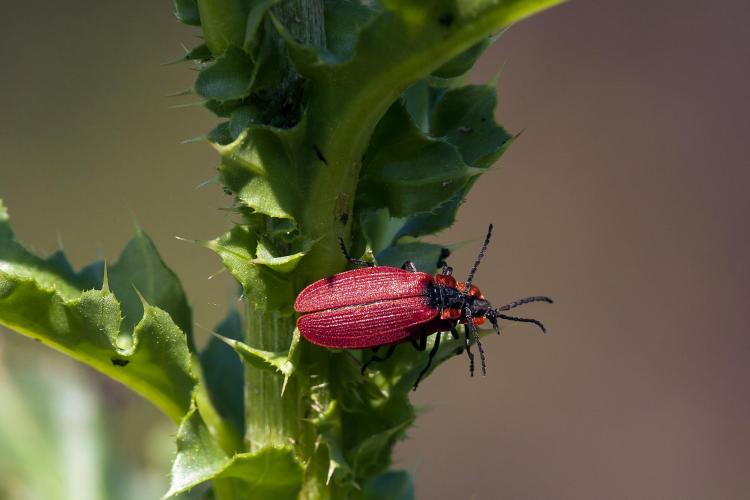Net-winged beetles advertise defenses with brilliant color, noxious odor
Trilobite beetles are perhaps the most bizarre of all the net-winged beetles
Some insects are cryptic, blending in with their backgrounds to hide from predators, while others are brightly colored, noisy, or form dense and conspicuous aggregations to warn their predators away. Red net-winged beetles, Dictyoptera aurora, are exemplars of this second group—brilliant red elytra (wing covers), feeding and mating where they are plainly visible and slow movement or no effort at all to avoid a predator. In each of my encounters with them, they have completely disregarded me, even when I approached within two feet with a macro lens.
I remember sighting a mating pair of beetles on Flagstaff Mountain from a distance and noting that they were indifferent to my approach; I vowed to return the next morning with a camera. The next morning, the male still had the female in his grasp, protecting his paternal investment until she started to lay eggs. Their bright coloration and indifference to predators and humans are clear indications that they are effectively protected and have no need to hide or flee.
Net-winged beetles are named for their network of longitudinal and transverse ridges adorning the elytra."
Approximately 2,800 species of net-winged beetles have been described and although they are predominantly tropical, they occur on all of the continents. They are saproxylic, meaning that they are dependent on dead and rotting wood in fallen trees. They are omnivores, acting both as predators of all smaller insects and consuming slime molds, fungi and rotting plant material. As adults, they eat nectar, pollen and small insects.
Net-winged beetles are named for their network of longitudinal and transverse ridges adorning the elytra. The hollow ridges are filled with blood containing pyrazines produced in the elytra. If the elytra are bent, they spill blood and the repugnant stench of pyrazines fills the air.
Pyrazines are in low concentration in blood, so they are not expected to be defensive, but are thought to announce the presence of toxic chemical defenses. So, net-wings have both aposematic or warning coloration and aposematic odor to discourage predators.

At the top of the page: A red net-wing beetle rides a slender stem in the breeze, indifferent to the people walking by. Photo by Jeff Mitton. Above: A male red net-wing beetle guards his paternal investment by clasping a female, denying access to other males. Photo by Jeff Mitton.
Net-winged beetles synthesize their molecular defense, a novel acetylenic acid named lycidic acid, for the family Lycidae. Lycidic acid is spilled from fractures in the elytral ridges, but beetles can also release it at will by reflexively bleeding—bending the leg joints and joints between the head, thorax and abdomen to express lycidic acid in blood.
Laboratory and field tests by Thomas Eisner and his colleagues at Cornell and Archbold Biological Station, FL with hermit thrushes, Swainson's thrushes, wolf spiders, orb-weaving spiders and ladybugs were used to test the efficacy of chemical defenses in several species of net-winged beetles. The results were similar with all the predators in the study—net-winged beetles containing lycidic acid and mealworms coated with lycidic acid were judged to be unpalatable.
Insects that contain or wield efficient defenses against predators often become the models for mimics lacking defenses."
Insects that contain or wield efficient defenses against predators often become the models for mimics lacking defenses. If a defenseless insect bears some small similarity to a well defended species, it gains greater protection from predators if it evolves greater similarity to the model—that is Batesian mimicry. Müllerian mimicry involves two defended species, each gaining greater protection when they evolve greater similarity.
At the Southwestern Research Station in Arizona, two net-winged beetles aggregate on blooms of white clover. But observations over several years revealed that each of the net-wing species was, in fact, two nearly identical or sibling species, Müllerian mimics, each benefitting by its similarity to the other. Furthermore, each pair of sibling species have two unrelated Batesian mimics—an undefended beetle mimic and an undefended moth. This is an incredibly complex aggregation of at least eight species all held together by lycidic acid.
Trilobite beetles are perhaps the most bizarre of all the net-winged beetles. The genus Platerodrilus (previously Duliticola) currently contains about 20 described species native to China, Southeast Asia and India. The adult males look like proper net-winged beetles, perhaps 8-9 mm, or 1/3 inch in length.
In striking contrast, mature females are 40 to 80 mm, or five to 10 times as long as males, but they bear no resemblance whatsoever to adult males. Female adult trilobite beetles are neotenic, meaning that they retain the body shape of a larva, which has heavy plates bearing recurved spikes, reminiscent of the trilobites that populated sea floors many millions of years ago. Furthermore, these slow, ponderous trilobitic females have brilliant colors—one found in Laos is a bright lavender.
I have always hoped that trilobites, like the enormous coelacanth fish long thought to be extinct, would be found lurking in some unlikely place. I am losing hope, but perhaps I can be satisfied to have learned about trilobite beetles.

